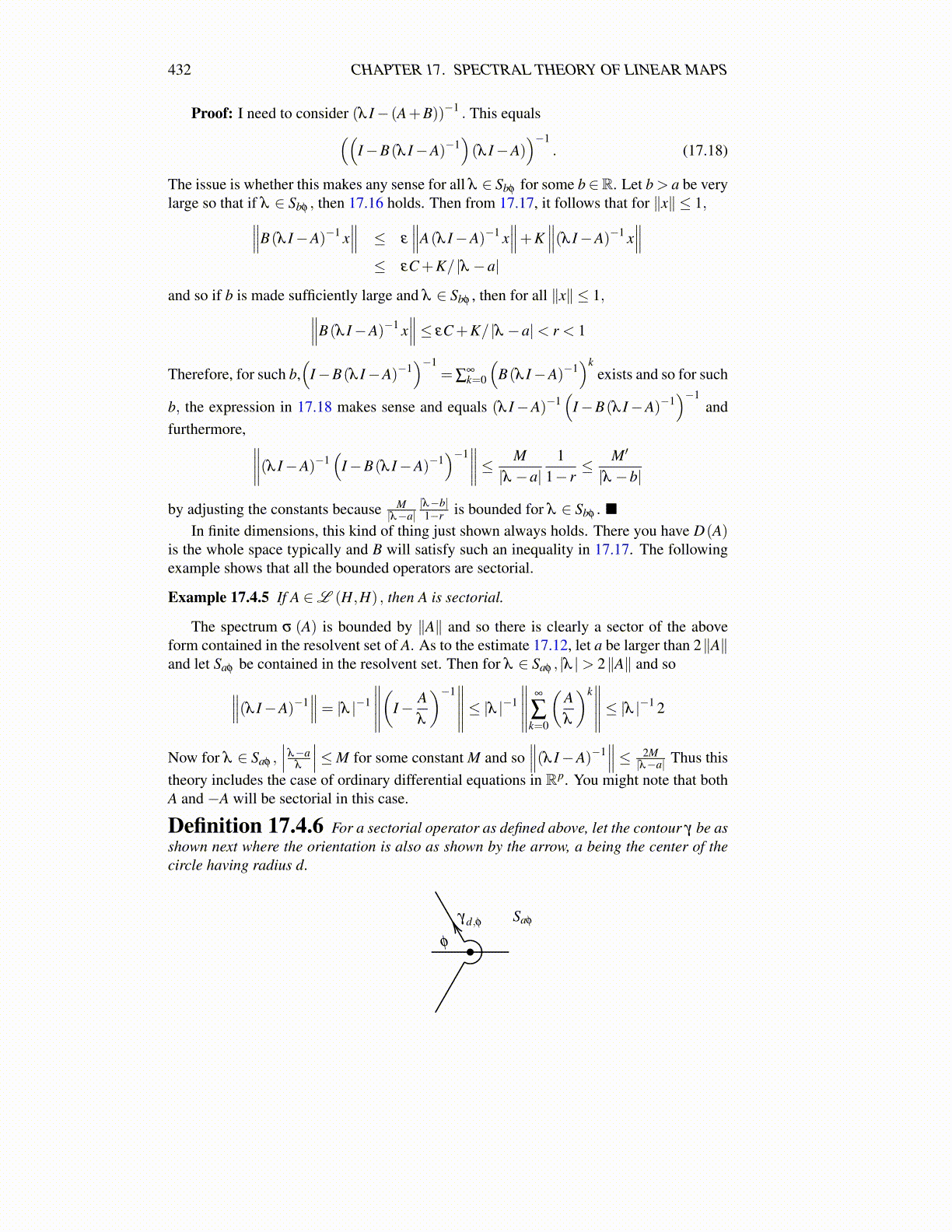
432 CHAPTER 17. SPECTRAL THEORY OF LINEAR MAPS
Proof: I need to consider (λ I− (A+B))−1 . This equals((I−B(λ I−A)−1
)(λ I−A)
)−1. (17.18)
The issue is whether this makes any sense for all λ ∈ Sbφ for some b∈R. Let b > a be verylarge so that if λ ∈ Sbφ , then 17.16 holds. Then from 17.17, it follows that for ∥x∥ ≤ 1,∥∥∥B(λ I−A)−1 x
∥∥∥ ≤ ε
∥∥∥A(λ I−A)−1 x∥∥∥+K
∥∥∥(λ I−A)−1 x∥∥∥
≤ εC+K/ |λ −a|
and so if b is made sufficiently large and λ ∈ Sbφ , then for all ∥x∥ ≤ 1,∥∥∥B(λ I−A)−1 x∥∥∥≤ εC+K/ |λ −a|< r < 1
Therefore, for such b,(
I−B(λ I−A)−1)−1
=∑∞k=0
(B(λ I−A)−1
)kexists and so for such
b, the expression in 17.18 makes sense and equals (λ I−A)−1(
I−B(λ I−A)−1)−1
andfurthermore, ∥∥∥∥(λ I−A)−1
(I−B(λ I−A)−1
)−1∥∥∥∥≤ M|λ −a|
11− r
≤ M′
|λ −b|
by adjusting the constants because M|λ−a|
|λ−b|1−r is bounded for λ ∈ Sbφ . ■
In finite dimensions, this kind of thing just shown always holds. There you have D(A)is the whole space typically and B will satisfy such an inequality in 17.17. The followingexample shows that all the bounded operators are sectorial.
Example 17.4.5 If A ∈L (H,H) , then A is sectorial.
The spectrum σ (A) is bounded by ∥A∥ and so there is clearly a sector of the aboveform contained in the resolvent set of A. As to the estimate 17.12, let a be larger than 2∥A∥and let Saφ be contained in the resolvent set. Then for λ ∈ Saφ , |λ |> 2∥A∥ and so∥∥∥(λ I−A)−1
∥∥∥= |λ |−1
∥∥∥∥∥(
I− Aλ
)−1∥∥∥∥∥≤ |λ |−1
∥∥∥∥∥ ∞
∑k=0
(Aλ
)k∥∥∥∥∥≤ |λ |−1 2
Now for λ ∈ Saφ ,∣∣∣λ−a
λ
∣∣∣≤M for some constant M and so∥∥∥(λ I−A)−1
∥∥∥≤ 2M|λ−a| Thus this
theory includes the case of ordinary differential equations in Rp. You might note that bothA and −A will be sectorial in this case.
Definition 17.4.6 For a sectorial operator as defined above, let the contour γ be asshown next where the orientation is also as shown by the arrow, a being the center of thecircle having radius d.
Saφγd,φ
φ